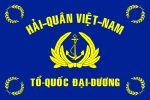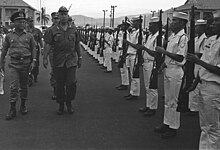| Republic of Vietnam Navy Hải quân Việt Nam Cộng hòa | |
|---|---|
 Emblem of the South Vietnamese Navy | |
| Founded | 1952 |
| Disbanded | 30 April 1975 |
| Country | |
| Branch | Navy |
| Role | Sea control |
| Size | 42,000 men, 1,400 ships, boats and other vessels (1973) |
| Part of | |
| Garrison/HQ | Saigon, South Vietnam |
| Nickname(s) | "HQVNCH" ("RVNN" in English) |
| Motto(s) | Tổ quốc — Đại dương ("The Fatherland — The Ocean") |
| March | Hải quân Việt Nam hành khúc |
| Anniversaries | 20 August |
| Engagements | Vietnam War Cambodian Civil War Battle of the Paracel Islands |
| Commanders | |
| Notable commanders | Trần Văn Chơn Cao Văn Viên Lâm Nguơn Tánh Chung Tấn Cang |
| Insignia | |
| Flag |  |
| Naval ensign |  |
| Flag of Saint Trần |  |


The Republic of Vietnam Navy (RVNN; Vietnamese: Hải quân Việt Nam Cộng hòa - HQVNCH; was the naval branch of the South Vietnamese military, the official armed forces of the former Republic of Vietnam (or South Vietnam) from 1955 to 1975. The early fleet consisted of boats from France; after 1955, and the transfer of the armed forces to Vietnamese control, the fleet was supplied from the United States. With American assistance, in 1972 the VNN became the largest Southeast Asian navy and, by some estimates, the fourth largest navy in the world, just behind the Soviet Union, the United States and the People's Republic of China,[1] with 42,000 personnel, 672 amphibious ships and craft, 20 mine warfare vessels, 450 patrol craft, 56 service craft, and 242 junks. Other sources state that VNN was the ninth largest navy in the world.[2] The Republic of Vietnam Navy was responsible for the protection of the country's national waters, islands, and interests of its maritime economy, as well as for the co-ordination of maritime police, customs service and the maritime border defence force.
The Republic of Vietnam Navy disbanded in 1975 with the collapse of South Vietnam, and North Vietnam's victory in the Vietnam War. Most of its fleet was captured in port, but a small fleet of vessels, led by Captain Đỗ Kiếm and Richard L. Armitage of the Defense Attaché Office, Saigon, escaped to Thailand and surrendered themselves to American naval forces there. Some of these RVNN vessels were scuttled upon reaching the open sea, while others continued their service with the Philippine Navy.
- ^ Fiscal Year 1972 Authorization for Military Procurement: Research and Development, Construction and Real Estate Acquisition for the Safeguard ABM, and Reserve Strengths. Hearings, Ninety-second Congress, First Session, on S. 939 (H.R. 8687). U.S. Government Printing Office. 1971.
- ^ "All Hands". 1970.